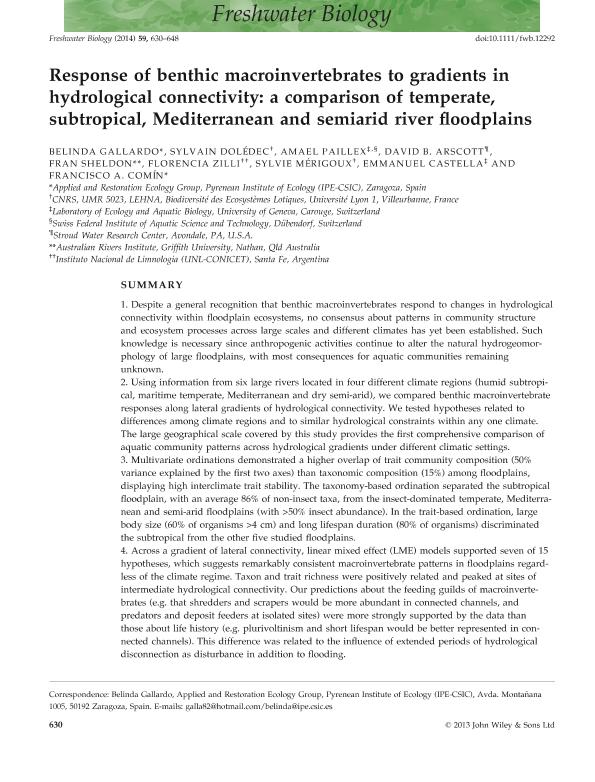Artículo
Response of benthic macroinvertebrates to gradients in hydrological connectivity: a comparison of temperate, subtropical, Mediterranean, and semiarid river floodplains
Gallardo, Belinda; Dolèdec, Sylvain; Paillex, Amael; Arscott, David B.; Sheldon, Fran; Zilli, Florencia Lucila ; Mérigoux, Sylvie; Castella, Emmanuel; Comín, Francisco A.
; Mérigoux, Sylvie; Castella, Emmanuel; Comín, Francisco A.
 ; Mérigoux, Sylvie; Castella, Emmanuel; Comín, Francisco A.
; Mérigoux, Sylvie; Castella, Emmanuel; Comín, Francisco A.
Fecha de publicación:
12/2013
Editorial:
Wiley
Revista:
Freshwater Biology (print)
ISSN:
0046-5070
e-ISSN:
1365-2427
Idioma:
Inglés
Tipo de recurso:
Artículo publicado
Clasificación temática:
Resumen
1) Despite a general recognition that benthic macroinvertebrates respond to changes in hydrological connectivity within floodplain ecosystems, no consensus about patterns in community structure and ecosystem processes across large scales and different climates has yet been established. Such knowledge is necessary since anthropogenic activities continue to alter the natural hydrogeomorphology of large floodplains, with most consequences for aquatic communities remaining unknown.
2) Using information from six large rivers located in four different climate regions (humid subtropical, maritime temperate, Mediterranean and dry semi-arid), we compared benthic macroinvertebrate responses along lateral gradients of hydrological connectivity. We tested hypotheses related to differences among climate regions and to similar hydrological constraints within any one climate. The large geographical scale covered by this study provides the first comprehensive comparison of aquatic community patterns across hydrological gradients under different climatic settings.
3) Multivariate ordinations demonstrated a higher overlap of trait community composition (50% variance explained by the first two axes) than taxonomic composition (15%) among floodplains, displaying high interclimate trait stability. The taxonomy-based ordination separated the subtropical floodplain, with an average 86% of non-insect taxa, from the insect-dominated temperate, Mediterranean and semi-arid floodplains (with >50% insect abundance). In the trait-based ordination, large body size (60% of organisms >4 cm) and long lifespan duration (80% of organisms) discriminated the subtropical from the other five studied floodplains.
4) Across a gradient of lateral connectivity, linear mixed effect (LME) models supported seven of 15 hypotheses, which suggests remarkably consistent macroinvertebrate patterns in floodplains regardless of the climate regime. Taxon and trait richness were positively related and peaked at sites of intermediate hydrological connectivity. Our predictions about the feeding guilds of macroinvertebrates (e.g. that shredders and scrapers would be more abundant in connected channels, and predators and deposit feeders at isolated sites) were more strongly supported by the data than those about life history (e.g. plurivoltinism and short lifespan would be better represented in connected channels). This difference was related to the influence of extended periods of hydrological disconnection as disturbance in addition to flooding.
5) Trait stability across hydrological connectivity provides a meaningful ecological context for the comparison of the macroinvertebrate benthos among climatic zones, where taxonomic composition differs strongly. In addition, trait similarities and dissimilarities found in this study suggest that large-scale biogeographical filters do operate on communities, resulting in different trait combinations in temperate and Mediterranean floodplains when compared to semi-arid and subtropical environments. The extent to which global macroecological factors (i.e. climate, dispersal history) and local biotic and abiotic factors (i.e. drought frequency, habitat structure, water chemistry) contribute to this difference requires further investigation.
Archivos asociados
Licencia
Identificadores
Colecciones
Articulos(INALI)
Articulos de INST.NAC.DE LIMNOLOGIA (I)
Articulos de INST.NAC.DE LIMNOLOGIA (I)
Citación
Comín, Francisco A.; Castella, Emmanuel; Paillex, Amael; Dolèdec, Sylvain; Mérigoux, Sylvie; Zilli, Florencia Lucila; et al.; Response of benthic macroinvertebrates to gradients in hydrological connectivity: a comparison of temperate, subtropical, Mediterranean, and semiarid river floodplains; Wiley; Freshwater Biology (print); 59; 3; 12-2013; 630-648
Compartir
Altmétricas
Items relacionados
Mostrando titulos relacionados por título, autor y tema.
-
Bena, María Julia ; Sirolli, Horacio; Kalesnik, Fabio Alberto (Sociedad Argentina de Botánica, 2015-12)
-
Casado, Ana Lia (Universidad Nacional del Sur. Departamento de Geografía y Turismo, 2017-06)
-
Neschuk, Nancy Carolina; Claps, Maria Cristina ; Gabellone, Nestor Adrian (EDP Sciences, 2002-12)



